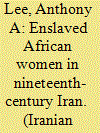| Srl | Item |
| 1 |
ID:
111193


|
|
|
|
|
| Publication |
2012.
|
| Summary/Abstract |
Fezzeh Khanom (c. 1835-82), an African woman, was a slave of Sayyed 'Ali-Mohammad of Shiraz, the Bab. Information about her life can be recovered from various pious Baha'i histories. She was honored, and even venerated by Babis, though she remained subordinate and invisible. The paper makes the encouraging discovery that a history of African slavery in Iran is possible, even at the level of individual biographies. Scholars estimate that between one and two million slaves were exported from Africa to the Indian Ocean trade in the nineteenth century, most to Iranian ports. Some two-thirds of African slaves brought to Iran were women intended as household servants and concubines. An examination of Fezzeh Khanom's life can begin to fill the gaps in our knowledge of enslaved women in Iran. The paper discusses African influences on Iranian culture, especially in wealthy households and in the royal court. The limited value of Western legal distinctions between slavery and freedom when applied to the Muslim world is noted.
|
|
|
|
|
|
|
|
|
|
|
|
|
|
|
|
| 2 |
ID:
114660


|
|
|
|
|
| Publication |
2012.
|
| Summary/Abstract |
Charles Prinsep, a prosperous Calcutta lawyer and sometime advocate general of the East India Company, was active amongst a network of British entrepreneurs in India who were enthusiastic about an Indian Ocean sub-empire, the potential of the Australian colonies to become trading partners with India, and their prospects as destinations for British residents to settle after their Indian service. During the 1820s and 1830s, Prinsep embarked on a series of ventures to purchase land, establish shipping links and export indentured Indian labour to Australia. In Australia, agriculturalists and merchants were also interested in the potential of Indian indenture schemes to respond to projected shortages of labour with the demise of convictism in the Eastern Australian colonies. A number of shipments of indentured Indian labourers arrived in Australia during the 1830s. These schemes were opposed by the Colonial Office and by many in Australia, particularly urban dwellers, who feared that such a 'degradation' of the labour market would discourage European settlement in the Australian colonies, which they wanted reserved for Europeans, that other great diaspora of the nineteenth century.
|
|
|
|
|
|
|
|
|
|
|
|
|
|
|
|
| 3 |
ID:
177594


|
|
|
|
|
| Summary/Abstract |
The Mughal emperor Jahangir (reigned 1605–1627) was a knowledgeable naturalist with a keen interest in exotic fauna. In 1612 C.E. a strange primate was obtained from the Portuguese in Goa and brought to his court. The emperor’s written description of the animal and a contemporary painting suggest it was a lemur and therefore from Madagascar. Although many animals from the Moluccas and several from eastern Africa reached Jahangir, this is the only Madagascan animal to do so. Jahangir’s careful description of the animal and an illustration commissioned for his memoirs pre-date European scientific descriptions by a dozen years and reveal Jahangir as a fore-runner of comparative, descriptive zoology.
|
|
|
|
|
|
|
|
|
|
|
|
|
|
|
|